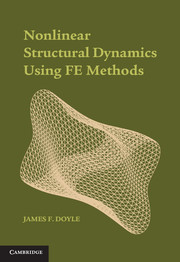Book contents
1 - Dynamics of Simple Elastic Systems
from PART I - MECHANICS AND MODELS
Published online by Cambridge University Press: 05 October 2014
Summary
This chapter is concerned with the formulation of the equations of motion (EoM) of simple systems. What is meant by simple is that the systems have just a single degree of freedom (SDoF) and does not imply that the underlying mechanics is simple or elementary in any way.
The concept of vibration is fundamental to understanding the dynamics of elastic structures. The study of vibration is concerned with the oscillatory motion of bodies; all bodies with elasticity and mass are capable of exhibiting vibrations. Resonant (or natural) frequencies are the frequencies at which a structure exhibits relatively large response amplitudes for relatively small inputs. Even if the excitation forces are not sinusoidal, these frequencies tend to dominate the response. In practice, large resonant responses are mitigated by the presence of damping and nonlinear effects. Damping is considered in this chapter, whereas the effects of nonlinearities are distributed throughout the other chapters. The use of Fourier analysis (or spectral analysis) as a means of describing time-varying behavior is essential to the study of structural dynamics, and this too is developed in this chapter.
Motion of Simple Systems
This section reviews the dynamics of elastic systems in the form of a spring-mass-dashpot. We restrict the emphasis to concepts that are used directly in this and later chapters. References 45, 81, and 83 are good sources for additional details on the material covered here.
- Type
- Chapter
- Information
- Nonlinear Structural Dynamics Using FE Methods , pp. 7 - 53Publisher: Cambridge University PressPrint publication year: 2014

